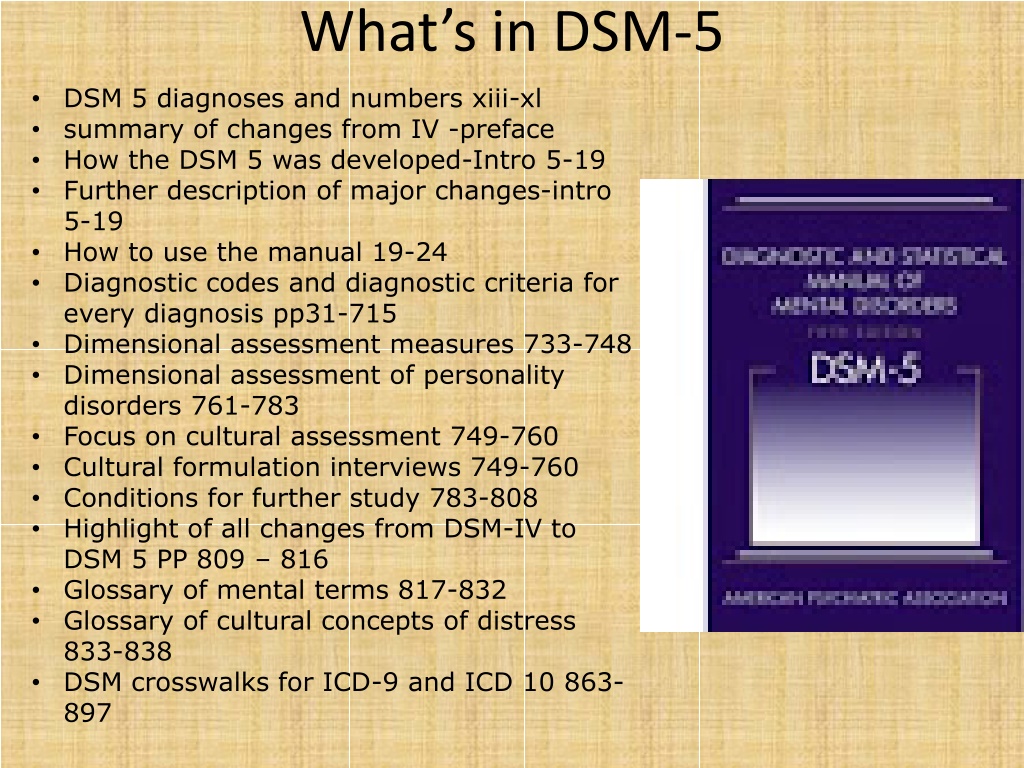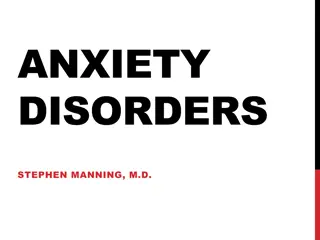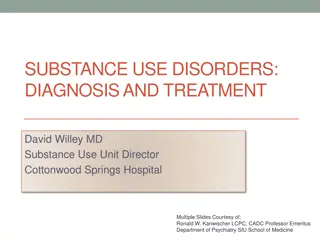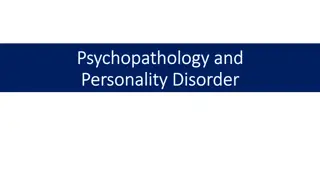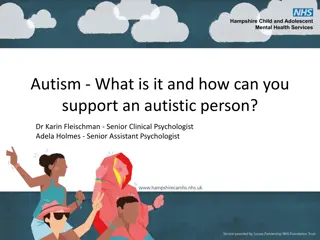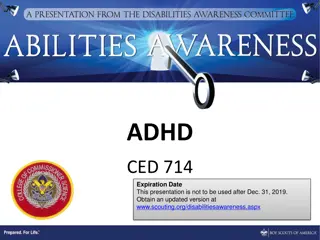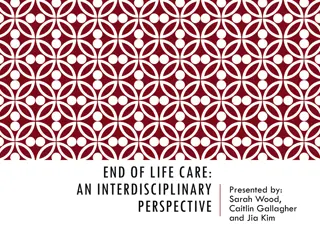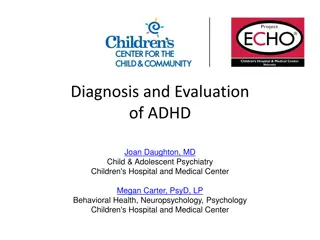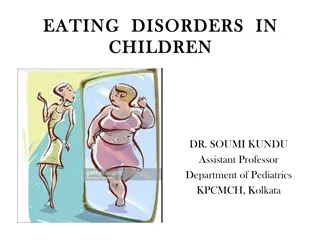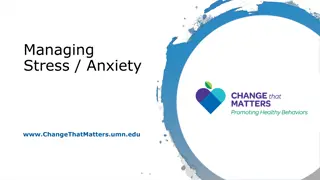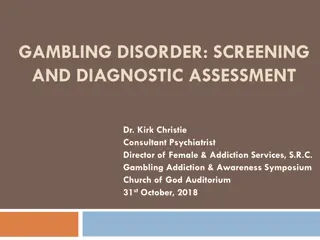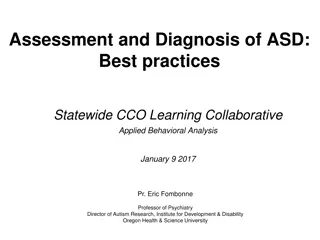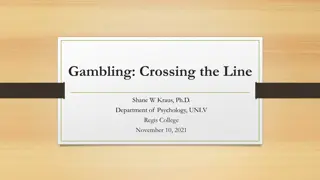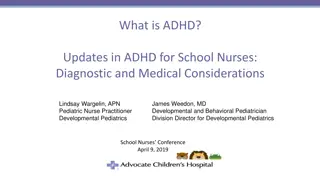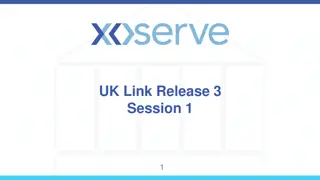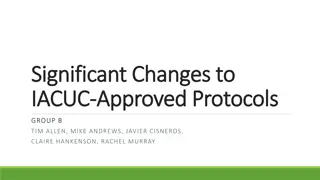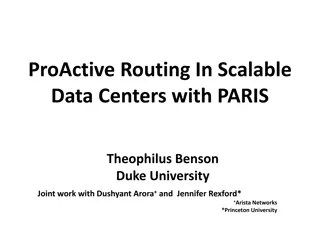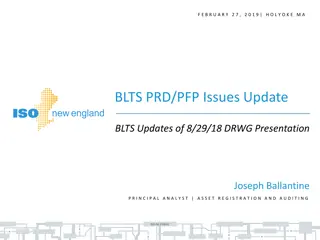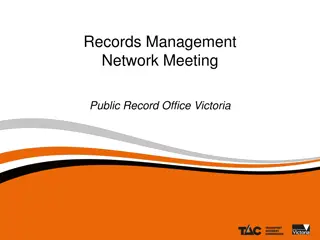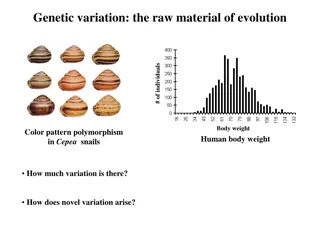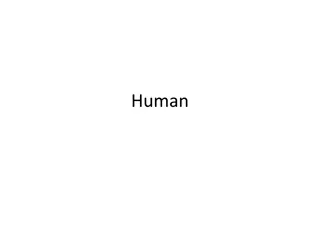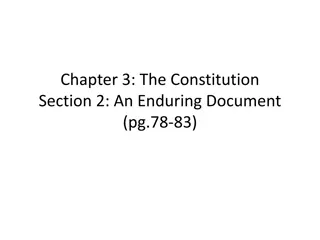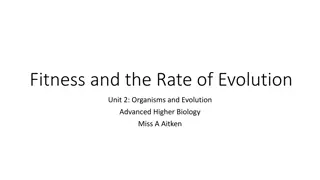Evolution from DSM-IV to DSM-5: Understanding Changes and Challenges
The transition from DSM-IV to DSM-5 was driven by the need to improve diagnostic accuracy, reflect shared symptomatology, integrate new research findings, and enhance cultural considerations. DSM-5 addressed shortcomings such as the multi-axial structure, unreliable measures like GAF, and the focus on immediate diagnoses. Additionally, it aimed to incorporate advancements in neuroscience and genetics, provide dimensional assessments, and emphasize well-being over mere symptom negation.
Download Presentation

Please find below an Image/Link to download the presentation.
The content on the website is provided AS IS for your information and personal use only. It may not be sold, licensed, or shared on other websites without obtaining consent from the author. Download presentation by click this link. If you encounter any issues during the download, it is possible that the publisher has removed the file from their server.
E N D
Presentation Transcript
Whats in DSM-5 DSM 5 diagnoses and numbers xiii-xl summary of changes from IV -preface How the DSM 5 was developed-Intro 5-19 Further description of major changes-intro 5-19 How to use the manual 19-24 Diagnostic codes and diagnostic criteria for every diagnosis pp31-715 Dimensional assessment measures 733-748 Dimensional assessment of personality disorders 761-783 Focus on cultural assessment 749-760 Cultural formulation interviews 749-760 Conditions for further study 783-808 Highlight of all changes from DSM-IV to DSM 5 PP 809 816 Glossary of mental terms 817-832 Glossary of cultural concepts of distress 833-838 DSM crosswalks for ICD-9 and ICD 10 863- 897
DSM-IVs organizational structure failed to reflect shared features or symptoms of related disorders and diagnostic groups (like psychotic disorders with bipolar disorders, or internalizing (depressive, anxiety, somatic) and externalizing (impulse control, conduct, substance use) disorders.
Did not represent or integrate the latest findings from neuroscience, genetics and cognitive research
Multi axial structure was out of line with the rest of medicine
Global assessment of functioning was an unreliable measure Decision trees did not increase inter-rater reliability
Other problems Separates diagnoses from treatment Diagnosis has become an end in itself! (billability & pressure for scientific determinism) Minimizes TIME as a major factor in making diagnoses Minimizes emergent symptoms Minimizes lack of symptom clarity as an issue Ignores internal unobservables Funnels tx focus to symptom negation rather than well- being Forces clinician to make immediate diagnoses Forces clinician to more severe DX
There have been no no established "zones of rarity" between diagnosis (much symptom overlap) Law-like biological markers have not yet been found Categorical measurement (depressed vs NOT depressed) doesn t capture clinical variance
DSM III & IV limits Focus on only what is observable; limits diagnostic possibilities Limited number of observable signs & symptoms (12 to 19 symptoms ) Because law-like biomarkers have not been found, Elements that cannot be seen directly are excluded. This is exactly the opposite of medicine which strives to see below the surface. Limited number of observable signs/symptoms But 400 diagnoses in DSM = diagnostic confusion Simple counting of the number of symptoms in Order to make a diagnosis DOES NOT WORK
DSM III & IV problems with measuring Limited number of observable signs and Symptoms, Elements that cannot be seen directly are excluded. This is exactly the opposite of medicine which strives to see below the surface. Limited number of observable signs/symptoms But 400 diagnoses in DSM # 1 Problem = under- determination of diagnosis Consequences = - boundary problems (paris) - false positives - rise of comorbidity - problems of differential dx - one size fits all diagnoses - only agreement on most severe
The relationship between Categorical Dx, comorbidity and increased reliability 1. no major depression; 2. major depression 1. No generalized anxiety 2. generalized anxiety Depression 4 1 2 3 None minimal mild minor moderate major severe maximal 5 6 7 8 General anxiety 1 2 3 4 5 6 7 8 None minimal mild minor moderate major severe maximal Categorical measurement increases potential for inter-rater reliability. 50% chance of inter-rater reliability Dimensional measure inter-rater reliability lower = 12% Fewer choices = easier= less information = more possibility of making mistake = inflated comorbidity More choices = harder= more info Subtle distinctions ; less Potential for specious comorbidity Categorical measures = No clinical variance & no diagnostic threshold Decreasing variance increases potential for inter rater reliability and increases potential for specious comorbidity
DSM III & IV turned assessment into yes/no decision trees Inflated comorbidity Inflated inter-rater reliability (but did not increase it) Never established true biological markers Reduced the rigorousness of good assessment in the name of clinical utility
DSM 5 1. Emphasizes dimensional measurement 2. Provides World Health Organization measure of overall well-being 3. Does away with Axes 4. Focuses more on culture 5. Attempts to Re-organize diagnostic categories according to what we now (think we)know 6. Attempts to re-group individual diagnoses according to what we now (think we) know 7. Includes crosswalks with ICD-9 and ICD 10 http://www.dsm5.org/Pages/Default.aspx
1. Dimensional measures http://www.psychiatry.org/practice/dsm/dsm5/online-assessment-measures#Level1 Allows clinician opportunity to fine tune diagnosis Captures diagnostic complexity Should reduce inflated comorbidity. By allowing inclusion of crosscutting symptoms (such as anxiety) within other diagnoses Focuses assessment on crosscutting symptoms Creates "severity specifier" for many diagnoses Dimensions make diagnosis congruent with up- to-date neurocognitive research indicating symptoms are on a continuum
DSM 5 adds dimensional measures WITHOUT abandoning categorical measures Criteria are basically the same as they were in the DSM-IV
Crosscutting symptoms (symptoms that can occur across many DXs) Captures symptom comorbidity without diagnostic comorbidity Cross-cutting symptom measures may aid in a comprehensive mental status assessment by drawing attention to symptoms that are important across diagnoses. They are intended to help identify additional areas of inquiry that may guide treatment and prognosis. The cross- cutting measures have two levels: Level 1 questions are a brief survey of 13 domains for adult patients and 12 domains for child and adolescent patients, and Level 2 questions provide a more in-depth assessment of certain domains. http://www.psychiatry.org/practice/dsm/dsm5/online-assessment-measures#Level1
Table 1: Adult DSM-5 Self-Rated Level 1 Cross-Cutting Symptom Measure: domains, thresholds for further inquiry, and associated Level 2 measures for adults ages 18 and over Domain Domain Name DSM-5 Level 2 Cross-Cutting Symptom Measure available online Threshold to guide further inquiry I. Depression Mild or greater LEVEL 2 Depression Adult (PROMIS Emotional Distress Depression Short Form)1 II. Anger Mild or greater LEVEL 2 Anger Adult (PROMIS Emotional Distress Anger Short Form)1 III. IV. Mania Mild or greater Mild or greater LEVEL 2 Mania Adult (Altman Self-Rating Mania Scale) LEVEL 2 Anxiety Adult (PROMIS Emotional Distress Anxiety Short Form)1 Anxiety V. Somatic Symptoms Mild or greater LEVEL 2 Somatic Symptom Adult (Patient Health Questionnaire 15 Somatic Symptom Severity [PHQ-15]) VI. VII. VIII. Suicidal Ideation Psychosis Sleep Problems Slight or greater Slight or greater Mild or greater None None LEVEL 2 Sleep Disturbance - Adult (PROMIS Sleep Disturbance Short Form)1 IX. X. Memory Mild or greater Mild or greater None LEVEL 2 Repetitive Thoughts and Behaviors Adult (adapted from the Florida Obsessive-Compulsive Inventory [FOCI] Severity Scale [Part B]) Repetitive Thoughts and Behaviors XI. XII. Dissociation Personality Functioning Substance Use Mild or greater Mild or greater None None XIII. Slight or greater LEVEL 2 Substance Abuse Adult (adapted from the NIDA-modified ASSIST)
DSM-5 Self-Rated Level 1 Cross-Cutting Symptom MeasureAdult None Slight Mild Moderate Severe Highest During the past TWO (2) WEEKS, how much (or how often) have you been bothered by the following problems? Not at all Rare, less than a day or two Several days More than half the days Nearly every day Domain Score (clinician) I. 1. Little interest or pleasure in doing things? 0 1 2 3 4 2. Feeling down, depressed, or hopeless? 0 1 2 3 4 II. 3. Feeling more irritated, grouchy, or angry than usual? 0 1 2 3 4 III. 4. Sleeping less than usual, but still have a lot of energy? 0 1 2 3 4 0 1 2 3 4 5. Starting lots more projects than usual or doing more risky things than usual? IV. 6. Feeling nervous, anxious, frightened, worried, or on edge? 0 1 2 3 4 7. Feeling panic or being frightened? 0 1 2 3 4 8. Avoiding situations that make you anxious? 0 1 2 3 4 V. 9. Unexplained aches and pains (e.g., head, back, joints, abdomen, legs)? 0 1 2 3 4 10. Feeling that your illnesses are not being taken seriously enough? 0 1 2 3 4 VI. 11. Thoughts of actually hurting yourself? 0 1 2 3 4 VII. 0 1 2 3 4 12. Hearing things other people couldn t hear, such as voices even when no one was around? 13. Feeling that someone could hear your thoughts, or that you could hear what another person was thinking? 0 1 2 3 4 VIII. 14. Problems with sleep that affected your sleep quality over all? 0 1 2 3 4 IX. 15. Problems with memory (e.g., learning new information) or with location (e.g., finding your way home)? 0 1 2 3 4 X. 16. Unpleasant thoughts, urges, or images that repeatedly enter your mind? 0 1 2 3 4 17. Feeling driven to perform certain behaviors or mental acts over and over again? 0 1 2 3 4 XI. 18. Feeling detached or distant from yourself, your body, your physical surroundings, or your memories? 0 1 2 3 4 XII. 19. Not knowing who you really are or what you want out of life? 0 1 2 3 4 20. Not feeling close to other people or enjoying your relationships with them? 0 1 2 3 4 XIII. 21. Drinking at least 4 drinks of any kind of alcohol in a single day? 0 1 2 3 4 22. Smoking any cigarettes, a cigar, or pipe, or using snuff or chewing tobacco? 0 1 2 3 4 0 1 2 3 4 23. Using any of the following medicines ON YOUR OWN, that is, without a doctor s prescription, in greater amounts or longer than prescribed [e.g., painkillers (like Vicodin), stimulants (like Ritalin or Adderall), sedatives or tranquilizers (like sleeping pills or Valium), or drugs like marijuana, cocaine or crack, club drugs (like ecstasy), hallucinogens (like LSD), heroin, inhalants or solvents (like glue), or methamphetamine (like speed)]?
THE CROSS-CUTTING SYMPTOM MEASURES CAN DO THREE THINGS 1. POINT YOU IN THE RIGHT DIRECTION DIAGNOSTICALLY (LEVEL I) 2. GIVE YOU A BASIC SENSE OF THE CLINICAL PROFILE OF EACH CLINET 3. CAPTURE SYMPTOMS THAT ARE LIKELY TO OCCUR ACROSS DIAGNOSIS, BUT NOT NECESSARILY QUALIFY FOR ITS OWN DX DEPRESSION ANXIETY SOMATIC SYMPTOMS SLEEP ISSUES ETC.
level II measures(Dimensional) Level II crosscutting measures Focus on one specific domain Provides a more varied clinical profile within that domain Allows for follow-up exploration with more than one domain in order to specify diagnostic boundaries. (For example, in my dealing with major depression with a co-occurring anxiety disorder or major depression, with anxious features Provides clinical verification before diagnosis
Level 2 measures of symptoms Level 2 questions provide a more in-depth assessment of certain domains: http://www.psychiatry.org/practice/dsm/dsm 5/online-assessment-measures# Level2 Level 2 is given as a specific follow up, once the clinician is oriented in a symptomatic direction they are focused WITHIN a specific symptom domain
List of all the level 2 (disorder specific) cross-cutting symptom measures Level 2 Cross-Cutting Symptom Measures For Adults LEVEL 2 Depression Adult (PROMIS Emotional Distress Depression Short Form) LEVEL 2 Anger Adult (PROMIS Emotional Distress Anger Short Form) LEVEL 2 Mania Adult(Altman Self-Rating Mania Scale [ASRM]) LEVEL 2 Anxiety Adult(PROMIS Emotional Distress Anxiety Short Form) LEVEL 2 Somatic Symptom Adult(Patient Health Questionnaire 15 Somatic Symptom Severity Scale [PHQ-15]) LEVEL 2 Sleep Disturbance Adult(PROMIS Sleep Disturbance Short Form) LEVEL 2 Repetitive Thoughts and Behaviors Adult(Adapted from the Florida Obsessive-Compulsive Inventory [FOCI] Severity Scale [Part B]) LEVEL 2 Substance Use Adult (Adapted from the NIDA-Modified ASSIST) For Parents of Children Ages 6 17 LEVEL 2 Somatic Symptom Parent/Guardian of Child Age 6 17 (Patient Health Questionnaire 15 Somatic Symptom Severity Scale [PHQ-15]) LEVEL 2 Sleep Disturbance Parent/Guardian of Child Age 6 17 (PROMIS Sleep Disturbance Short Form) LEVEL 2 Inattention Parent/Guardian of Child Age 6 17 (Swanson, Nolan, and Pelham, version IV [SNAP-IV]) LEVEL 2 Depression Parent/Guardian of Child Age 6 17 (PROMIS Emotional Distress Depression Parent Item Bank) LEVEL 2 Anger Parent/Guardian of Child Age 6 17 (PROMIS Emotional Distress Calibrated Anger Measure Parent) LEVEL 2 Irritability Parent/Guardian of Child Age 6 17 (Affective Reactivity Index [ARI]) LEVEL 2 Mania Parent/Guardian of Child Age 6 17 (Adapted from the Altman Self-Rating Mania Scale [ASRM]) LEVEL 2 Anxiety Parent/Guardian of Child Age 6 17 (Adapted from PROMIS Emotional Distress Anxiety Parent Item Bank) LEVEL 2 Substance Use Parent/Guardian of Child Age 6 17 (Adapted from the NIDA-Modified ASSIST) For Children Ages 11 17 LEVEL 2 Somatic Symptom Child Age 11 17 (Patient Health Questionnaire 15 Somatic Symptom Severity Scale [PHQ-15]) LEVEL 2 Sleep Disturbance Child Age 11 17 (PROMIS Sleep Disturbance Short Form) LEVEL 2 Depression Child Age 11 17 (PROMIS Emotional Distress Depression Pediatric Item Bank) LEVEL 2 Anger Child Age 11 17 (PROMIS Emotional Distress Calibrated Anger Measure Pediatric) LEVEL 2 Irritability Child Age 11 17 (Affective Reactivity Index [ARI]) LEVEL 2 Mania Child Age 11 17 (Altman Self-Rating Mania Scale [ASRM]) LEVEL 2 Anxiety Child Age 11 17 (PROMIS Emotional Distress Anxiety Pediatric Item Bank) LEVEL 2 Repetitive Thoughts and Behaviors Child Age 11 17 (Adapted from the Children s Florida Obsessive Compulsive Inventory [C-FOCI] Severity Scale) LEVEL 2 Substance Use Child Age 11 17 (Adapted from the NIDA-Modified ASSIST)
Table 1: Adult DSM-5 Self-Rated Level 1 Cross-Cutting Symptom Measure: domains, thresholds for further inquiry, and associated Level 2 measures for adults ages 18 and over Hypothetically scores on our client using level I crosscutting symptoms indicated the following areas circled Domain Domain Name DSM-5 Level 2 Cross-Cutting Symptom Measure available online Threshold to guide further inquiry b I. Depression Mild or greater LEVEL 2 Depression Adult (PROMIS Emotional Distress Depression Short Form)1 II. Anger Mild or greater LEVEL 2 Anger Adult (PROMIS Emotional Distress Anger Short Form)1 III. IV. Mania Mild or greater Mild or greater LEVEL 2 Mania Adult (Altman Self-Rating Mania Scale) LEVEL 2 Anxiety Adult (PROMIS Emotional Distress Anxiety Short Form)1 Anxiety b b V. Somatic Symptoms Mild or greater LEVEL 2 Somatic Symptom Adult (Patient Health Questionnaire 15 Somatic Symptom Severity [PHQ-15]) VI. VII. VIII. Suicidal Ideation Psychosis Sleep Problems Slight or greater Slight or greater Mild or greater b None None LEVEL 2 Sleep Disturbance - Adult (PROMIS Sleep Disturbance Short Form)1 IX. X. Memory Mild or greater Mild or greater None LEVEL 2 Repetitive Thoughts and Behaviors Adult (adapted from the Florida Obsessive-Compulsive Inventory [FOCI] Severity Scale [Part B]) Repetitive Thoughts and Behaviors XI. XII. Dissociation Personality Functioning Substance Use Mild or greater Mild or greater None None XIII. Slight or greater b LEVEL 2 Substance Abuse Adult (adapted from the NIDA-modified ASSIST)
LEVEL 2DepressionAdult* *PROMIS Emotional DistressDepressionShort Form Name: Age: Sex: MaleFemale Date:_ If the measure is being completed by an informant, what is your relationship with the individual receiving care? In a typical week, approximately how much time do you spend with the individual receiving care? hours/week Instructions: On the DSM-5 Level 1 cross-cutting questionnaire that you just completed, you indicated that during the past 2 weeks you (the individual receiving care) have been bothered by no interest or pleasure in doing things and/or feeling down, depressed, or hopeless at a mild or greater level of severity. The questions below ask about these feelings in more detail and especially how often you (the individual receiving care) have been bothered by a list of symptoms during the past 7 days. Please respond to each item by marking (P or x) one box per row. Clinician Use In the past SEVEN (7) DAYS.... Item Score Never Rarely Sometimes Often Always 1. I felt worthless. q 1 q 2 q 3 q 4 q 5 2. I felt that I had nothing to look forward to. q 1 q 2 q 3 q 4 q 5 3. I felt helpless. q 1 q 2 q 3 q 4 q 5 4. I felt sad. q 1 q 2 q 3 q 4 q 5 5. I felt like a failure. q 1 q 2 q 3 q 4 q 5 6. I felt depressed. q 1 q 2 q 3 q 4 q 5 7. I felt unhappy. q 1 q 2 q 3 q 4 q 5 8. I felt hopeless. q 1 q 2 q 3 q 4 q 5 Total/Partial Raw Score: Prorated Total Raw Score: T-Score:
LEVEL 2Substance UseAdult* *Adapted from the NIDA-Modified ASSIST Name: Age: Sex: q Male q Female Date: If the measure is being completed by an informant, what is your relationship with the individual receiving care? In a typical week, approximately how much time do you spend with the individual receiving care? Instructions: On the DSM-5 Level 1 cross-cutting questionnaire that you just completed, you indicated that during the past 2 weeks you (the individual receiving care) have been bothered by using medicines on your own without a doctor s prescription, or in greater amounts or longer than prescribed, and/or using drugs like marijuana, cocaine or crack, and/or other drugs at a slight or greater level of severity. The questions below ask how often you (the individual receiving care) have used these medicines and/or substances during the past 2 weeks. Please respond to each item by marking (P or x) one box per row. hours/week During the past TWO (2) WEEKS, about how often did you use any of the following medicines ON YOUR OWN, that is, without a doctor s prescription, in greater amounts or longer than prescribed? Clinician Use One or two days Several days More than half the days Nearly every day Item Score Not at all a. Painkillers (like Vicodin) q 0 q 1 q 2 q 3 q 4 b. Stimulants (like Ritalin, Adderall) Sedatives or tranquilizers (like sleeping pills or Valium) q 0 q 1 q 2 q 3 q 4 c. q 0 q 1 q 2 q 3 q 4 Or drugs like: d. Marijuana q 0 q 1 q 2 q 3 q 4 e. Cocaine or crack q 0 q 1 q 2 q 3 q 4 f. Club drugs (like ecstasy) q 0 q 1 q 2 q 3 q 4 g. Hallucinogens (like LSD) q 0 q 1 q 2 q 3 q 4 h. Heroin q 0 q 1 q 2 q 3 q 4 i. Inhalants or solvents (like glue) q 0 q 1 q 2 q 3 q 4 j. Methamphetamine (like speed) q 0 q 1 q 2 q 3 q 4 Total Score: Useless for alcohol. Perhaps ADS
Level 2 cross-cutting scale for Somatic symptoms - Adult LEVEL 2 Somatic Symptom Adult Patient* *Adapted from the Patient Health Questionnaire Physical Symptoms (PHQ-15) Name: Age: Sex: q Male q Female Date: If the measure is being completed by an informant, what is your relationship with the individual receiving care? In a typical week, approximately how much time do you spend with the individual receiving care? hours/week Instructions: On the DSM-5 Level 1 cross-cutting questionnaire that you just completed, you indicated that during the past 2 weeks you (the individual receiving care) have been bothered by unexplained aches and pains , and/or feeling that your illnesses are not being taken seriously enough at a mild or greater level of severity. The questions below ask about these feelings in more detail and especially how often you (the individual receiving care) have been bothered by a list of symptoms during the past 7 days. Please respond to each item by marking (P or x) one box per row. Clinician Use Item Score During the past 7 days, how much have you been bothered by any of the following problems? Not bothered at all 0 Bothered a little 1 Bothered a lot 2 1. Stomach pain 2. Back pain 3. Pain in your arms, legs, or joints (knees, hips, etc.) 4. Menstrual cramps or other problems with your periods WOMEN ONLY 5. Headaches 6. Chest pain 7. Dizziness 8. Fainting spells 9. Feeling your heart pound or race 10. Shortness of breath 11. Pain or problems during sexual intercourse 12. Constipation, loose bowels, or diarrhea 13. Nausea, gas, or indigestion 14. Feeling tired or having low energy 15. Trouble sleeping Total/Partial Raw Score: Prorated Total Raw Score: (if 1-3 items left unanswered)
LEVEL 2AnxietyAdult* *PROMIS Emotional DistressAnxietyShort Form Name: Age: Sex: q Male q Female Date: If the measure is being completed by an informant, what is your relationship with the individual? In a typical week, approximately how much time do you spend with the individual? hours/week Instructions to patient: On the DSM-5 Level 1 cross-cutting questionnaire that you just completed, you indicated that during the past 2 weeks you (individual receiving care) have been bothered by feeling nervous, anxious, frightened, worried, or on edge , feeling panic or being frightened , and/or avoiding situations that make you anxious at a mild or greater level of severity. The questions below ask about these feelings in more detail and especially how often you (individual receiving care) have been bothered by a list of symptoms during the past 7 days. Please respond to each item by marking (P or x) one box per row. Clinician Use In the past SEVEN (7) DAYS.... Item Score Never Rarely Sometimes Often Always 1. I felt fearful. q 1 q 2 q 3 q 4 q 5 2. I felt anxious. q 1 q 2 q 3 q 4 q 5 3. I felt worried. q 1 q 2 q 3 q 4 q 5 4. I found it hard to focus on anything other than my anxiety. q 1 q 2 q 3 q 4 q 5 5. I felt nervous. q 1 q 2 q 3 q 4 q 5 6. I felt uneasy. q 1 q 2 q 3 q 4 q 5 7. I felt tense. q 1 q 2 q 3 q 4 q 5 Total/Partial Raw Score: Prorated Total Raw Score: T-Score:
Level 2 cross-cutting scale for anxiety in children parent filled Instructions to parent/guardian: On the DSM-5 Level 1 cross-cutting questionnaire that you just completed, you indicated that during the past 2 weeks your child receiving care has been bothered by feeling nervous, anxious, or scared , not being able to stop worrying , and/or couldn t do things he/she wanted to or should have done because they made him/her feel nervous at a mild or greater level of severity. The questions below ask about these feelings in more detail and especially how often your child receiving care has been bothered by a list of symptoms during the past 7 days. Please respond to each item by marking ( or x) one box per row. In the past SEVEN (7) DAYS, my child said that he/she Clinician use Never 1 almost never 2 Sometimes 3 Often 4 Almost always 5 Item score 1. Felt like something awful might happen 2. Felt nervous 3. Felt scared 4. Felt worried 5. Worried about what could happen to him/her. 6. Worried when he/she went to bed at night 7. Got scared really easy. 8. Was afraid of going to school. 9 Worried when he/she was at home 10. Worried when he/she was away from home Total/partial raw score Prorated total raw score T-score
LEVEL 2Sleep DisturbanceAdult* *PROMISSleep DisturbanceShort Form Name: Age: Sex: q Male q Female Date: If the measure is being completed by an informant, what is your relationship with the individual receiving care? In a typical week, approximately how much time do you spend with the individual receiving care? hours/week Instructions to patient: On the DSM-5 Level 1 cross-cutting questionnaire that you just completed, you indicated that during the past 2 weeks you (the individual receiving care) have been bothered by problems with sleep that affected your sleep quality over all at a mild or greater level of severity. The questions below ask about these feelings in more detail and especially how often you (the individual receiving care) have been bothered by a list of symptoms during the past 7 days. Please respond to each item by marking (P or x) one box per row. Clinician Use In the past SEVEN (7) DAYS.... Not at all A little bit Somewhat Quite a bit Very much q 1 q 2 q 3 q 4 q 5 1. My sleep was restless. q 5 q 4 q 3 q 2 q 1 2. I was satisfied with my sleep. q 5 q 4 q 3 q 2 q 1 3. My sleep was refreshing. q 1 q 2 q 3 q 4 q 5 4. I had difficulty falling asleep. In the past SEVEN (7) DAYS.... Never Rarely Sometimes Often Always q 1 q 2 q 3 q 4 q 5 5. I had trouble staying asleep. q 1 q 2 q 3 q 4 q 5 6. I had trouble sleeping. q 5 q 4 q 3 q 2 q 1 7. I got enough sleep. In the past SEVEN (7) DAYS.... Very Poor Poor Fair Good Very good q 5 q 4 q 3 q 2 q 1 8. My sleep quality was... Total/Partial Raw Score: Prorated Total Raw Score: T-Score:
DIMENSIONAL SEVERITY MEASURES In addition to a diagnosis, DSM MEASURES SEVERITY OF MANY DIAGNOSIS SEVERITY HAS NEVER BEEN CONSISTENTLY MEASURED IN DSM UNTIL NOW ONE EITHER WAS PSYCHOTIC OR ONE WAS NOT THERE WERE NO GRADATIONS
Severity - The DSM uses 2 methods of assessing severity, depending on the diagnosis.. Method 1 involves using a specific dimensional measure or scale Called disorder specific severity measures . These can be find on the DSM 5 website under online assessment measures (DIMENSIONAL SCALE ) Method 2 involves counting the number of symptoms and rating severity based on number of symptoms. For example, mild alcohol use Disorder = 2 3 symptoms: moderate alcohol use disorder = 4 5 symptoms; severe alcohol use Disorder= presence of 6 or more symptoms (Total number of diagnostic crtieria)
Disorder-Specific Severity Measures For Adults Severity Measure for Depression Adult(Patient Health Questionnaire [PHQ-9]) Severity Measure for Separation Anxiety Disorder Adult Severity Measure for Specific Phobia Adult Severity Measure for Social Anxiety Disorder (Social Phobia) Adult Severity Measure for Panic Disorder Adult Severity Measure for Agoraphobia Adult Severity Measure for Generalized Anxiety Disorder Adult Severity of Posttraumatic Stress Symptoms Adult(National Stressful Events Survey PTSD Short Scale [NSESS]) Severity of Acute Stress Symptoms Adult(National Stressful Events Survey Acute Stress Disorder Short Scale [NSESS]) Severity of Dissociative Symptoms Adult(Brief Dissociative Experiences Scale [DES-B]) For Children Ages 11 17 Severity Measure for Depression Child Age 11 17 (PHQ-9 modified for Adolescents [PHQ-A] Adapted) Severity Measure for Separation Anxiety Disorder Child Age 11 17 Severity Measure for Specific Phobia Child Age 11 17 Severity Measure for Social Anxiety Disorder (Social Phobia) Child Age 11 17 Severity Measure for Panic Disorder Child Age 11 17 Severity Measure for Agoraphobia Child Age 11 17 Severity Measure for Generalized Anxiety Disorder Child Age 11 17 Severity of Posttraumatic Stress Symptoms Child Age 11 17 (National Stressful Events Survey PTSD Short Scale [NSESS]) Severity of Acute Stress Symptoms Child Age 11 17 (National Stressful Events Survey Acute Stress Disorder Short Scale [NSESS]) Severity of Dissociative Symptoms Child Age 11 17 (Brief Dissociative Experiences Scale [DES-B]) Clinician-Rated Clinician-Rated Severity of Autism Spectrum and Social Communication Disorders Clinician-Rated Dimensions of Psychosis Symptom Severity (also available in print book) Clinician-Rated Severity of Somatic Symptom Disorder Clinician-Rated Severity of Oppositional Defiant Disorder Clinician-Rated Severity of Conduct Disorder Clinician-Rated Severity of Nonsuicidal Self-Injury
This document is found on page 743 of the DSM. It allows the clinician to rate all of the salient dimensions that might be present in a disorder on the schizophrenia spectrum - IN TERMS OF SEVERITY - using Likert scale to rate the dimensions
Psycho-social HX MSE DSM 5 criteria for major depression A. Five or more of the following symptoms of been present during the same two-week period and represent a change from previous functioning; at least one of the symptoms is either depressed mood or loss of interest or pleasure 1. Depressed mood most of the day, nearly every day as indicated by subjective reporter observation. Yes or no 2. Marked diminished interest or pleasure in all our almost all activities. Most of the day, nearly every day. Yes or no 3. Significant weight loss when not dieting or weight gain or decrease in appetite, nearly every day. Yes or no 4. Insomnia or hypersomnia nearly every day. Yes or no 5. Psychomotor agitation or retardation nearly every day. Yes or no 6. Fatigue or loss of energy nearly every day. Yes or no 7. Feelings of worthlessness or excessive or inappropriate guilt. Yes or no 8. Diminished ability to think or concentrate or indecisiveness nearly every day. Yes or no 9. Recurrent thoughts of death or recurrent suicidal ideation or suicide attempt Yes or no 1. Lead with level I crosscutting symptom measures to assess all symptom domains 2. Follow-up with level II crosscutting measures in order to capture clinical nuances and potential comorbid B. The symptoms cause clinically significant distress or impairment Yes or no C. The episode is not attributable to the physiological effects of a substance or another medical condition Yes or no D. The occurrence of the major depressive disorder is not better explained by schizoaffective schizophrenia schizophreniform or anything else on the schizophrenia spectrum Yes or no E. There has never been a manic episode or hypomanic episode Yes or no 3. Move to categories and check off criteria 4. Assess severity
Adapted from the Patient Health Questionnaire9 (PHQ-9) depression Name: Age: Sex: Male q Female q Date: Instructions: Over the last 7 days, how often have you been bothered by any of the following problems? Clinician Use Item score More than half the days Nearly every day Not at all Several days 1. Little interest or pleasure in doing things 0 1 2 3 2. Feeling down, depressed, or hopeless 0 1 2 3 3. Trouble falling or staying asleep, or sleeping too much 0 1 2 3 4. Feeling tired or having little energy 0 1 2 3 5. Poor appetite or overeating 0 1 2 3 Feeling bad about yourself or that you are a failure or have let yourself or your family down 6. 0 1 2 3 Trouble concentrating on things, such as reading the newspaper or watching television 7. 0 1 2 3 Moving or speaking so slowly that other people could have noticed? Or the opposite being so fidgety or restless that you have been moving around a lot more than usual 8. 0 1 2 3 Thoughts that you would be better off dead or of hurting yourself in some way 9. 0 1 2 3 Total/Partial Raw Score: Prorated Total Raw Score: (if 1-2 items left unanswered) Levels of depressive symptoms severity None Mild depression Moderate depression Moderately severe depression Severe depression PHQ-9 Score 0-4 5-9 10-14 15-19 20-27
Alcohol use disorder A. Problematic pattern of alcohol use leading to clinically significant impairment or distress as manifested by at least two of the following occurring within a 12 month period 1. 2. 3. 4. 5. 6. 7. 8. 9. 10. Tolerance, as defined by a. Increased amounts needed to achieve intoxication or b. Diminished effect Of alcohol 11. Withdrawal From alcohol Alcohol taken in larger amount (need more for increased effect) Persistent desire or efforts to quit Using alcohol Time spent to obtain, use, recover from effects Of alcohol Cravings Or urges to use Alcohol Failure to fulfill significant roles Continued use Alcohol despite persistent and recurrent problems Important social/occupational activities are reduced Recurrent use Of alcohol in physically hazardous situations Use Of alcohol continues despite knowledge of impact of the problem Severity Mild = presence of 2-3 symptoms moderate = presence of four five symptoms severe = presence of six or more symptoms Course specifiers early remission = after full criteria were l for at least three months but less than 12 (with the exception of craving) In sustained remission = after full criteria were previously met none exists except craving during the period of 12 months or more previously met none of the criteria met
2. NO MORE GAF WHODAS DSM IV-TR- HAD SOMETHING CALLED THE GLOBAL ASSESSMENT OF FUNCTIONING THE ONLY DIMENSIONAL MEASURE IN THE DSM IV TR USED BY CLINICIAN; COMPLETELY UNRELIABLE AND NOT VALID REPLACED WITH A SCALE THAT HAS RELIABILITY AND VALIDITY DATA THE WORLD HEALTH ORGANIZATION DISABLITY ASSESSMENT SCALE (WHODAS PP 745-749)
DSM 5 recommends the following 1. Assess symptom severity/severity of diagnosis-use severity scales 2. Use dimensional scales or standardized scales whenever possible 3. Assess suicidality, capacity for self harm or harming others- use separate assessment protocol 4. Use World Health Organization disability assessment scale to assess social and self- care functioning
WHODAS 2.0 Based on the International Classification of Functioning, Disability, and Health (ICF) Applicable to any health condition Reliability and clinical utility established in DSM 5 Field trials
see pages 745 to 748 in DSM 5 WHODAS Assesses the following six areas 1. Understanding and communicating 2. Getting around 3. Self-care 4. Getting along with people 5. Life activities 6. Participation in society
STANDARDIZED WAY TO MEASURE HEALTH AND DISABILITY ACROSS CULTURES DOES NOT TARGET SPECIFIC DISEASE, SO CAN BE USED TO ASSESS DISABILITY ACROSS DISEASE WHODAS 36 ITEM ON NEXT 3 SLIDES (PP745-749 IN DSM) Domain 1 Cognition In the past 30 days, how much difficulty did you have in: Extreme or cannot do None Mild Moderate Severe Concentrating on doing something for ten minutes? D1.1 1 2 3 4 5 D1.2 Remembering to do important things? 1 2 3 4 5 D1.3 Analysing and finding solutions to problems in day-to-day life? 1 2 3 4 5 Learning a new task, for example, learning how to get to a new place? D1.4 1 2 3 4 5 Generally understanding what people say? D1.5 1 2 3 4 5 D1.6 Starting and maintaining a conversation? 1 2 3 4 5 Domain 2 Mobility In the past 30 days, how much difficulty did you have in: D2.1 Standing for long periods such as 30 minutes? Extreme or cannot do None Mild Moderate Severe 1 2 3 4 5 D2.2 Standing up from sitting down? 1 2 3 4 5 D2.3 Moving around inside your home? 1 2 3 4 5 D2.4 Getting out of your home? 1 2 3 4 5 Walking a long distance such as a kilometre [or equivalent]? D2.5 1 2 3 4 5
Domain 3 Self-care In the past 30 days, how much difficulty did you have in: Extreme or cannot do None Mild Moderate Severe D3.1 Washing your whole body? 1 2 3 4 5 D3.2 Getting dressed? 1 2 3 4 5 D3.3 Eating? 1 2 3 4 5 D3.4 Staying by yourself for a few days? 1 2 3 4 5 Domain 4 Getting along with people In the past 30 days, how much difficulty did you have in: Extreme or cannot do None Mild Moderate Severe D4.1 D4.2 D4.3 Dealing with people you do not know? Maintaining a friendship? Getting along with people who are close to you? 1 1 1 2 2 2 3 3 3 4 4 4 5 5 5 D4.4 D4.5 Making new friends? Sexual activities? 1 1 2 2 3 3 4 4 5 5 Domain 5 LIFE ACTIVITIES Because of your health condition, in the past 30 days, how much difficulty did you have in: Extreme or cannot do None Mild Moderate Severe Taking care of your household responsibilities? D5.1 1 2 3 4 5 Doing your most important household tasks well? D5.2 1 2 3 4 5 Getting all the household work done that you needed to do? Getting your household work done as quickly as needed? D5.3 1 2 3 4 5 D5.4 1 2 3 4 5 Domain 5 WORK OR SCHOOL ACTIVITIES Because of your health condition, in the past 30 days how much difficulty did you have in: D5.5 Your day-to-day work/school? D5.6 Doing your most important work/school tasks well? Extreme or cannot do 5 5 None Mild Moderate Severe 1 1 2 2 3 3 4 4 Getting all the work done that you need to do? D5.7 1 2 3 4 5 Getting your work done as quickly as needed? D5.8 1 2 3 4 5 D5.9 Have you had to work at a lower level because of a health condition? No Yes No Yes 1 2 1 2 D5.10 Did you earn less money as the result of a health condition?
Domain 6 Participation Extreme or cannot do In the past 30 days: None Mild Moderate Severe How much of a problem did you have joining in community activities (for example, festivities, religious or other activities) in the same way as anyone else can? D6.1 1 2 3 4 5 How much of a problem did you have because of barriers or hindrances in the world around you? D6.2 1 2 3 4 5 How much of a problem did you have living with dignity because of the attitudes and actions of others? D6.3 1 2 3 4 5 How much time did you spend on your health condition or its consequences? D6.4 1 2 3 4 5 D6.5 How much have you been emotionally affected by your health condition? 1 2 3 4 5 How much has your health been a drain on the financial resources of you or your family? D6.6 1 2 3 4 5 How much of a problem did your family have because of your health problems? D6.7 1 2 3 4 5 How much of a problem did you have in doing things by yourself for relaxation or pleasure? D6.8 1 2 3 4 5
If WHODAS is used, place results at the very end of assessment, after psychosocial stressors
3. How to chart without axes DSM-5 has moved to a nonaxial documentation of diagnosis (formerly Axes I, II, and III), with separate notations for important psychosocial and contextual factors (formerly Axis IV) and disability (formerly Axis V) Taken from Northstar behavioral health system http://www.northstarbehavioral.com/Overview%20of%20DSM%205%20changes%20HO%20Ver sion%20for%20Web%208-13-13.pdf
Axis IV - psychosocial and environmental factors - are now covered through an expanded set of V codes. V codes allow clinicians to indicate other conditions that may be a focus of clinical attention or affect diagnosis, course, prognosis or treatment of a mental disorder Axis V - CGAS and GAF - are replaced by separate measures of symptoms severity and disability for individual disorders. Change to the World Health Organization Disability Assessment Schedule (WHO DAS 2.0) Taken from Northstar behavioral health system http://www.northstarbehavioral.com/Overview%20of%20DSM%205%20changes%20HO %20Version%20for%20Web%208-13-13.pdf
All diagnoses are considered primary diagnosis All diagnoses are listed consecutively (no distinction between diagnosis previously listed on axis I, axis II or axis III) List diagnosis that is the reason for visit 1st Primary-reason for visit, 296.33, major depressive disorder, recurrent, severe. Primary- Medical condition; Parkinson s disease, moderate Primary-305.00 alcohol use disorder, mild. Primary -v15.81 non-adherence to medical treatment. (Patient continues to drink while on antidepressants and does not take antidepressants regularly.) If the principal diagnosis that is a reason for visit is a mental disorder caused by a medical condition, the medical condition is listed 1st Primary-Parkinson's disease-moderate with tremors and newly developed postural instability (scored 3 on Hoehn and Yahr) Primary-Reason for visit, 296.22; major depressive disorder, single episode, moderate
Case example for listing of DX John is a 65-year-old white male who is morbidly obese and has been a smoker for 40 years. He quit smoking 5 years ago after being diagnosed with Parkinson's disease. Over the last 5 years, John's ability to perform physical activity, has progressively deteriorated. Although John reports bouts of depression, beginning in adolescence and continuing throughout his adult life, he was not diagnosed with major depressive disorder until 4 years ago (one year after the diagnosis of Parkinson s). Since that time, he has been on several antidepressant medications, most recently Remeron. John reports that he has been a regular drinker since his days in college. Although he denies it, his alcohol use, according to his wife, has increased since his diagnosis of Parkinsons. However, upon evaluation both john and his wife agree that he drinks no more than 3 times per week usually a six pack. Although John has been advised to discontinue drinking, he has not done so. According to both John and his wife. He misses his medication anywhere from 1 to 3 times per week. About 3 months ago john fell while at home. His wife at first thought it was a result of his drinking. According to John he noticed that he was having more difficulty standing and walking while maintaining his A recent neurological consult indicates that John does NOT have any neurological deficits that are out of normal range for his age but has developed postural instability consistent with a progression of Parkinson s Despite advice to the contrary, John has become progressively more sedentary and has discontinued all forms of exercise. About 1 month ago, John's employers required that John start working part-time and consider filing for early Social Security. According to them, John's ability to work has diminished. They too noted that he was having difficulty walking. For the last 3 weeks, John has met all of the criteria for a severe episode of major depression. Primary diagnosis Primary-reason for visit, 296.33, major depressive disorder, recurrent, severe. Primary- Medical condition; Parkinson s disease-recently upgraded to moderate Primary-305.00 alcohol use disorder, mild. Primary -v15.81 non-adherence to medical treatment. Patient continues to drink while on antidepressants take antidepressants irregularly
